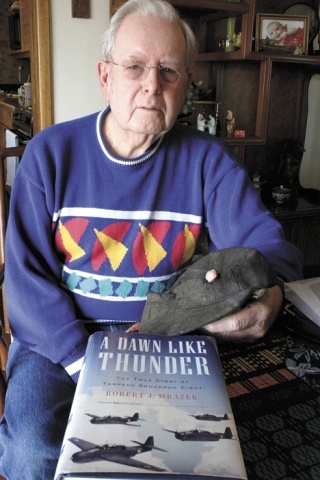“A Dawn Like Thunder” is a book that draws on the memories of Oak Harbor resident Harry Ferrier to depict the incredible courage of American aircrews during the early months of World War II in the Pacific, when the war’s outcome was very much in doubt.
Ferrier’s own story has been told several times locally, but the new book by acclaimed military author Robert J.Mrazek meticulously details “the true story of Torpedo Squadron Eight,” and how it turned the tide of battle at Midway on June 4, 1942.
Torpedo Squadron Eight was virtually wiped out that day, with only one surviving airplane. It started out with 15 Douglas TBD-1 Devastators on the USS Hornet and six Grumman TBF-1 Avengers on Midway Atoll. All 15 of the Devastators and five of the Avengers were shot down during the attacks on the Japanese carrier force, which was tasked with taking over the strategically-located atoll from the Americans. Japan had already attacked Pearl Harbor. A victory at Midway would have made the Pacific a Japanese lake, all the way to the West Coast of the U.S.
The Avenger flown by Bert Earnest, with 17-year-old Harry Ferrier as the tail-gunner, was the only one to survive the day. It made a celebrated landing at Midway, coming in on one wheel, having taken an incredible 64 machine gun hits and 9 cannon fire hits from Japanese Zeros and ships defending their fleet.
Ferrier has been wounded on the hand and knocked unconscious when a bullet grazed his head, making a hole in the ball cap he still displays to visitors. The other gunner on the plane, Jay Manning from Marysville, Wash., was killed.
Only three of the 48 airmen attached to Torpedo Squadron Eight survived, the other being George Gay, who was plucked from the ocean after bailing out of the plane he piloted.
It was the job of the torpedo planes to attack enemy ships by flying in low, just above the waves, and getting as close as possible before dropping their torpedoes. The Americans bravely flew into hailstorms of bullets fired from the Japanese carriers and support ships, and dodged Zeroes coming at them with guns blazing from all sides.
But it wasn’t a suicide mission, a fact that author Mrazek is quick to emphasize. Talking by phone from New York City where he was on a speaking engagement, he said of the Americans, “They would believe they would sink the enemy ships and get home safely. None of them had a death wish and none of them were suicidal. They had faith in one another and their leaders.”
The author particularly cited the leadership of the squadron commander, John Waldron. “He was incredibly charismatic, and the men had grown to admire him,” Mrazek said. “They would follow him into the jaw of death.”
And that’s exactly what they did.
Although Torpedo Squadron Eight paid an unbelievable toll, their heroic actions saved the day for the Americans. The Japanese carriers were kept busy fighting off the menacing torpedo planes. Ferrier was in one of the first six planes to arrive over the Japanese fleet, at 7 a.m.
“Their ferocity convinced Admiral Nagumo to change weapons,” Mrazek said. Japanese planes loaded with ship-killing ordnance switched to bombs, and later, back again, when Nagumo realized American carriers were in the area.
“It caused a tremendous delay,” Mrazek said. “It was the turning point.”
While the Japanese were preoccupied by the low-flying torpedo planes and changing weapons on their own planes, American diver bombers suddenly appeared 15,000 feet above the mayhem. It was a turkey shoot for the Americans.
In the span of five minutes, three of the four Japanese aircraft carriers were sunk or mortally wounded, and the battle was won for the Americans. It became known as “The Miracle at Midway.”
In preparing to write the book, Mrazek spoke at-length with Ferrier on several occasions. He spent seven years meticulously researching the lives and battles of the men in Torpedo Squadron Eight before sitting down to write.
“Harry was the best,” Mrazek said of his sources still alive from that long-ago day at Midway. “Harry created a lot of the color.” Much of the fascinating detail of day-to-day life at Midway and later, Guadalcanal, came from Ferrier, and Mrazek brings those details to life in his engrossing book.
Ferrier, who has lived on Whidbey for many years and is a former elected Island County auditor, said reading “A Dawn Like Thunder” was a learning experience for him, too.
“I learned a lot more than I ever knew,” he said.
That will no doubt hold true to anyone who reads the book. It’s nearly-500 pages are filled with details of the lives of the men in Torpedo Squadron Eight, living conditions in the Pacific, the battles they fought, and with maps and pictures of those who died defending their country.
“It was a labor of love, a privilege to write about these men,” Mrazek said. He enjoys going back in time and telling the stories of the World War II generation.
“I’m in full retreat from modern culture,” he said. “The values in this story, the sacrifice, honor and courage, need to be emphasized for a younger generation of Americans.”



